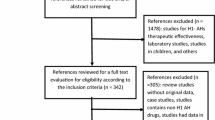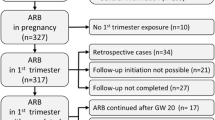Abstract
The objective of this study was to examine whether H2 blockers represent a major teratogenic risk. This prospective cohort study was done at the Motherisk Program, a Teratology Information Service, Toronto, Canada. The subjects included 178 women who contacted Motherisk about gestational H2-blocker use, and 178 controls matched for maternal age, smoking, and heavy alcohol consumption. The main outcome measures were primary—major malformations, and secondary—pregnancy outcome, method of delivery, gestational age, prematurity, birthweight, small for gestational age infants, neonatal health problems, and developmental milestones. No increase in major malformations was found following first trimester exposure to H2 blockers [2.1% vs 3.5% (controls), mean difference (95% CI) −1.4% (−5.2, +2.4)]. No other aspects of pregnancy outcome or neonatal health differed between groups. This study suggests that H2-blocker exposure during the first trimester does not represent a major teratogenic risk.
Similar content being viewed by others
References
Pope CE: Acid-reflux disorders. N Engl J Med 331(10):656–660, 1994
Advertising supplement. Warner Wellcome Consumer Healthcare, Glaxo, January 1995
Goodman Gilman A, Rall TW, Nies AS, Taylor P (eds): Goodman and Gilman's The Pharmacological Basis of Therapeutics, 8th ed. New York, McGraw-Hill, 1990
Briggs GG, Freeman RK, Yaffe SJ: Drugs in Pregnancy and Lactation, 4th ed. Baltimore, Williams and Wilkins, 1994
Colin Jones DG, Langman MJS, Lawson DH, Vessey MP: Post-marketing surveillance of the safety of cimetidine: Twelve-month morbidity report. Q J Med 54(215):253–268, 1985
Knott PD, Thorpe SS, Lamont CAR: Congenital renal dysgenesis possibly due to captopril. Lancet 1:451, 1989
Corazza GR, Gasbarrini G, DiNisio Q, Zulli P: Cimetidine (Tagamet) in peptic ulcer therapy during pregnancy: a report of three cases. Clin Trials J 19(2):91–92, 1982
Glade G, Saccar CL, Pereira GR: Cimetidine in pregnancy: Apparent transient liver impairment in the newborn. Am J Dis Child 134:87–88, 1980
Armentano G, Bracco PL, DiSilverio C: Ranitidine in the treatment of reflux oesophagitis in pregnancy. Clin Exp Obstet Gynecol 16(4):130–133, 1989
Cipriani S, Conti R, Vella G: Ranitidina in pregnancy. Three case reports. Clin Eur 22:1, 1983 (in Spanish)
Koren G, Zemlickis DM: Outcome of pregnancy after first trimester exposure to H2 receptor antagonists. Am J Perinatol 8(1):37–38, 1991
Maternal-Fetal Toxicology; A Clinician's Guide. New York, Marcel Dekker, 1994
Marden PM, Smith DW, McDonald MJ: Congenital anomalies in the newborn infant, including minor variations. J Pediatr 64:357–371, 1964
Usher R, McLean F: Intrauterine growth of live-born caucasian infants at sea level: standards obtained from measurements in 7 dimensions of infants born between 25 and 44 weeks of gestation. J Pediatr 74(6):901–910, 1969
Frankenburg WK: The Denver approach to early case finding.In Early Identification of Children at Risk. WK Frankenburg, RN Emde, JW Sullivan (eds). New York, Plenum Press, 1985, pp 135–158
Fleiss JL: Statistical Methods for Rates and Proportions. New York, John Wiley & Sons, 1973
Baron TH, Ramirez B, Richter JE: Gastrointestinal motility disorders during pregnancy. Ann Intern Med 118:366–375, 1993
Castro L de P: Reflux esophagitis as the cause of heartburn in pregnancy. Am J Obstet Gynecol 98:1–10, 1967
Schardein JL: Chemically Induced Birth Defects. New York, Marcel Dekker, 1985
Normal AP (ed): Congenital Abnormalities in Infancy, 2nd ed. Oxford, Blackwell Scientific Publications, 1971
Author information
Authors and Affiliations
Rights and permissions
About this article
Cite this article
Magee, L.A., Inocencion, G., Kamboj, L. et al. Safety of first trimester exposure to histamine H2 blockers. Digest Dis Sci 41, 1145–1149 (1996). https://doi.org/10.1007/BF02088230
Received:
Revised:
Accepted:
Issue Date:
DOI: https://doi.org/10.1007/BF02088230




